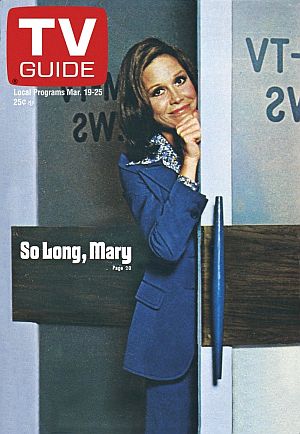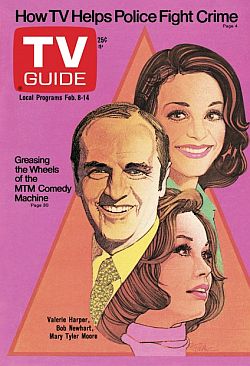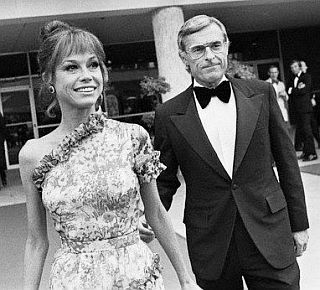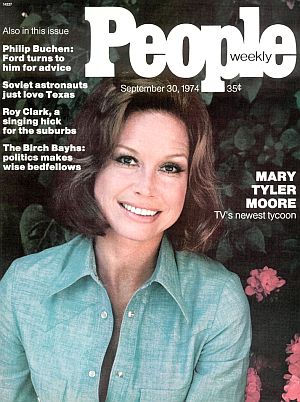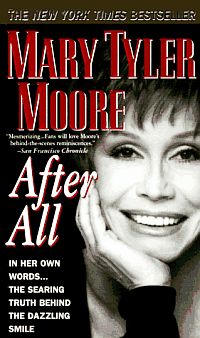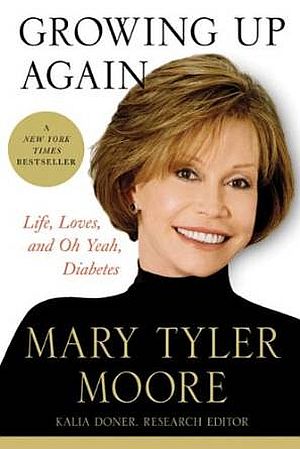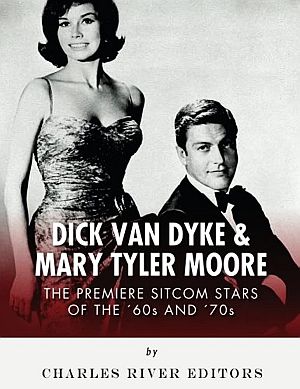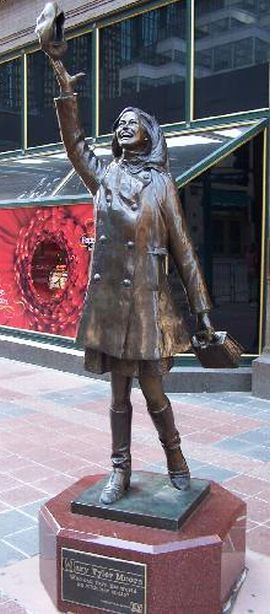
Statue of the fictional Mary Richards, the liberated TV producer of the “Mary Tyler Moore Show” (1970s) depicted tossing her tam into the air, a symbol of independence. Minneapolis, MN, 2002.
The statue at right, first installed on the streets of Minneapolis in May 2002, shows Mary Richards tossing her “tam” hat into the air. The scene – known as the “tam toss” and run in the opening credits of every episode – had become iconic; a symbol of Mary Richards’ independence. It was burnished in the minds of millions of fans and viewers who watched the show, both in the 1970s and later years in syndication. More on the show and the Minneapolis statue a bit later. First, a bit of biography on the lady at the center of this TV history, and also some focus on MTM Enterprises, a TV production company created in part by Moore and her then husband, Grant Tinker.
Brooklyn Girl
Mary Tyler Moore was born in Brooklyn, New York but her family moved to Los Angeles, California when she was a young girl of eight years old or so. She had attended Catholic school in Brooklyn and continued with Catholic schools through high school in California. While in high school she had aspired to be a dancer and began her career as a dancing elf in Hotpoint appliance TV commercials broadcast on the 1950s’ Ozzie and Harriet TV show.
Moore then did some anonymous modeling for record album covers. Trying her hand at TV acting, she was turned down for the role of the older daughter in The Danny Thomas Show.
Through the 1950s, she landed parts in a number of TV shows: Richard Diamond, Private Detective; Johnny Staccato a NBC detective series; two episodes of Overland Trail, an NBC western; and the first episode of NBC’s The Tab Hunter Show, a sitcom about a bachelor cartoonist. By 1961, she also had parts in other TV shows, among them: Bourbon Street Beat, 77 Sunset Strip, Surfside Six, Wanted: Dead or Alive, and Hawaiian Eye.
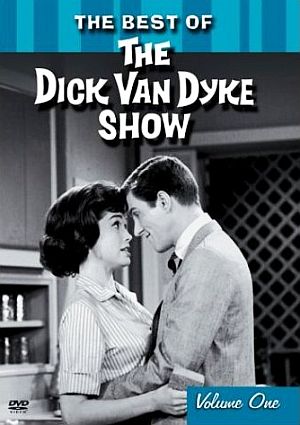
Mary Tyler Moore became popular as “Laura Petrie” in the 1960s’ “The Dick Van Dyke Show.” Click for DVD.
Although some 60 actresses auditioned for the part, Moore got the role after an interview with Carl Reiner, the creator of the show, who also became her mentor. With no experience in comedy, she nonetheless learned quickly, and soon proved to have a natural ability for comedic timing and related acting skills.
Dick Van Dyke, 11 years her senior when she began on the show, thought at first she would be too young. But later, he became one of her biggest fans.
The role of Laura Petri made her extremely popular and she became internationally famous. She would win Emmy awards for her acting on the Dick Van Dyke Show in 1964 and 1966, and a Golden Globe award in 1965.
Moore had been married when she was 18, giving birth in that marriage to her son, Richie, but was divorced in 1961. Not long after, she met Grant Tinker, then an executive with Benton & Bowles, the ad agency that represented The Dick Van Dyke Show‘s sponsor. In 1962, she and Tinker married.
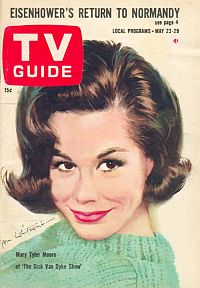
May 1964: Mary Tyler Moore of the Dick Van Dyke Show on TV Guide cover.
Moore by then was also trying to return to television, doing an April 1969 TV special with Dick Van Dyke that helped convince CBS brass to consider her for a new TV role. That’s when she and husband Grant Tinker pitched a new TV sitcom to CBS with Moore in the lead role. The show was offered as a half-hour newsroom sitcom featuring Ed Asner as Moore’s gruff boss, Lou Grant, with assorted other characters. That show became The Mary Tyler Moore Show.
Moore and Tinker by then had formed MTM Enterprises, an independent TV production company, initially to produce The Mary Tyler Moore Show, but would become a TV powerhouse in its own right (see sidebar later below). Tinker, who was then programming VP at Twentieth Century Fox’s television division, quit his job to launch and head up MTM Enterprises.
In The Mary Tyler Moore Show, the main character, Mary Richards, is a single, 30-something career woman who has come to Minneapolis after breaking up with a man she had been dating for several years.
Mary is competent and ambitious in her profession and is looking for new friends. She moves into one of the upstairs apartment units in an older Minneapolis home and begins work as an assistant news producer at local TV station, WJM.
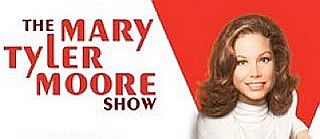 One title banner for “The Mary Tyler Moore Show.” |
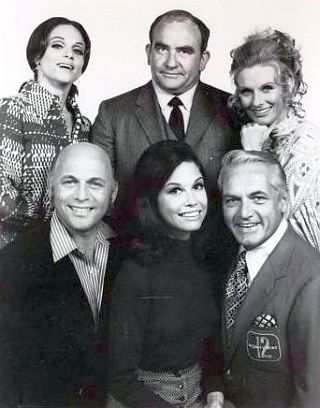 The original cast of “The Mary Tyler Moore Show,” 1970. Top: Valerie Harper (Rhoda), Ed Asner (Lou Grant), Cloris Leachman (Phyllis). Bottom: Gavin MacLeod (Murray), Mary Tyler Moore (Mary), Ted Knight (Ted Baxter). |
Mary works for chief news producer Lou Grant, an irascible kind of guy, seemingly harsh and gruff but actually a Mr. Softie, and a kind and gentle soul at heart.
Also among the newsroom characters in the show is Ted Baxter, projecting a self-importance and media aura about his role that is so far off the mark that he becomes a key comedic focus of the show, known for his on- and off-air gaffes.
In addition to Mary’s life at the office, the show also included sketches and story lines revolving around her home life and two other single woman and friends at her apartment. Among the latter, are Rhoda Morgenstern, upstairs neighbor played by Valerie Harper, and the downstairs landlady and friend, Phyllis Lindstrom, played by Cloris Leachman.
Among other subsequent characters who would appear in the show as it evolved were the station’s “Happy Homemaker Show” host, Sue Ann Nivens, played by Betty White, and Gordy, Gordon Howard, the weatherman, played by African American actor, John Amos. Gordy would appear roughly a dozen times over the course of the show’s first three seasons, and he eventually lands a job in New York City as a talk show host.
But it was Mary Richards who was the central character of the show, having a wide-ranging appeal to both sexes. In a 1974 interview with People magazine, Valery Harper, who played Rhoda, described Mary as follows:
“I want to tell you about my friend Mary Richards. She’s bouncy, she’s pretty, she weighs 11 pounds, and is a totally adorable human being. Despite that, I find it impossible to dislike her. Mary’s wholesome, but she’s not too wholesome. I mean, for example, she likes a great big glass of cold milk…to wash down her birth control pill. She’s the kind of person who gives WASPs a good name….”
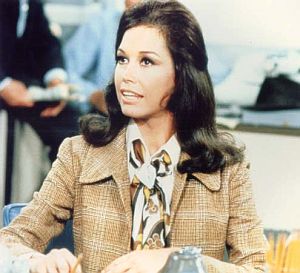 Mary Richards character at her desk at TV station WJM on “The Mary Tyler Moore Show.” |
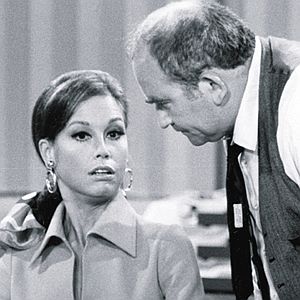 Ms. Richards here appears to be searching for an answer to a question from her boss, Lou Grant. |
 Mary Richards in the newsroom with Ted Baxter on the phone and weatherman Gordy Howard in the background. |
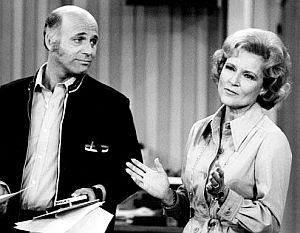 Newswriter Murray Slaughter listening to comment by Happy Homemaker show host, Sue Ann Nivens. |
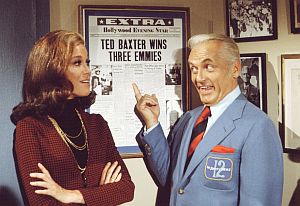 Ted Baxter boasting to Mary about his Emmy awards. |
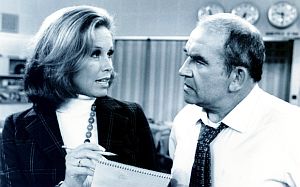 Mary Richards, who in later seasons of the show becomes a producer, in conversation with Lou Grant. |
The sketches on the show included various newsroom stories and the chronicles of Mary and her friends meeting men, or other escapades. Mary was interested in finding a man and raising a family, but not desperately so. In the show, she was cast as warm, loving, and vulnerable, and as one reviewer put it – but never specifically stated in the show as such – “a person who could spend the night with a man she was not madly in love with.”
The focus, however, wasn’t only on Mary, as viewers would get to know all the characters, as their situations developed throughout the series. Observes Geoff Hammill at the Museum of Broadcast Communications about the Lou Grant character:
“…Never static, each character changed in ways previously unseen in the [sitcom] genre. One of the best examples occurred when Lou divorced his wife of many years. His adjustment to the transition from married to divorced middle-aged man provided rich comic moments but also allowed viewers see new depths in the character, to see behind the gruff facade into Lou’s vulnerability, to grow closer to him. This type of evolution occurred with all the cast members, providing writers with constantly shifting perspective on the characters. From those perspectives new story lines could be developed and these fresh approaches helped renew a genre grown weary with repetition and familiar techniques. ..”
Initially, however, some of the early reviews of The Mary Tyler Moore Show were not good. Several well-known publications panned the pilot when it aired. A reviewer for Time magazine wrote that Mary’s “bosses, a drunken clown of a news director and a narcissistic nincompoop of an anchorman, do an injustice to even the worst of local TV news.” The New York Times called the show “preposterous,” while TV Guide said Rhoda, played by Valerie Harper (who would later be spun off in her own working woman show), was a “man-crazy klutz.” Despite the poor start, the show soon found its footing. In fact, a very loyal viewing audience followed that would keep the show in the top tier of the Neilsen ratings for the next six years.
By 1972, one reviewer from Time magazine wrote of the show:
“Someone should write an ode to Mary Tyler Moore, whose show seems to get better with every passing week. Now in its third year, the series has taken the brass of the usual situation comedy formula and transmuted it into something resembling gold.
…[T]he series has taken on a new and more interesting dimension. Still pretty, single and thirtyish, Mary is no longer the Doris Day-Julie Andrews brand of antiseptic woman. This year’s Mary is even a little naughty. On one recent show she kissed a boy friend rather soulfully while in the newsroom. On another she spent the night at some fellow’s pad, to the vocal dismay of her mother. Judging from this season’s shows, the new chemistry may provide just the pick-me-up a weary viewer needs.
The Mary Tyler Moore Show was a hit for most of its seven-year run, rated in the top 20 for six straight seasons. In its 7th year, however, the show slipped to No. 39.
The final episode of The Mary Tyler Moore Show aired in September 1977 to the dismay of its viewers. In the farewell episode, new management had taken over the station in the face of falling ratings, and everybody was fired, except anchorman Ted Baxter, the likely cause of the poor ratings. At the show’s end, there were tearful farewells with Mary the last one out, closing the door after a final look back.
For 25 years, the show held the record for most Emmys won.
Yet, for millions of fans, there was a second life to come for The Mary Tyler Moore Show – in syndication and reruns. In the New York region, for example, the show began a seven-year run in various time slots from 1977 through 1984 on the Nickelodeon channel. The reruns acquired a devoted nightly following of 75,000 viewers on New York’s WNBC-TV during those years. In that market, Mary Tyler Moore Show episodes aired at least 4,450 times during the 1977-1984 period. In 1992, Nick at Nite began evening broadcasts of the series and it became the network’s top-rated series. By 1993 The Mary Tyler Moore Show was still airing three times daily on the Nickelodeon cable network. In November 1995, one Chicago Tribune TV critic was recommending reruns of The Mary Tyler More Show on Nickelodeon over a then new Mary Tyler Moore sitcom, New York News, which the critic called a “less good” TV show. In fact, after setting the sit-com gold standard with The Mary Tyler Moore Show, Moore herself would have some difficulty in hitting that mark again with subsequent TV shows.
Impact & Legacy
Mary Richards and her friends and colleagues at WJM, came along at just the right time. The women’s movement by then was on the rise. A landmark book, The Feminine Mystique of 1963 by Betty Freidan, had already urged women to envision work outside the home. By 1972, the birth control pill had become available to all women, regardless of martial status. Also by then, the first issues of Ms. Magazine published by Gloria Steinem and Dorothy Pitman Hughes were on newsstands. And throughout the 1970s, women were on the march to add the Equal Rights Amendment (ERA) to the U.S. Constitution, passed by both houses of Congress in 1972, only to fall short of the 38 states needed for ratification during a decade-long fight.
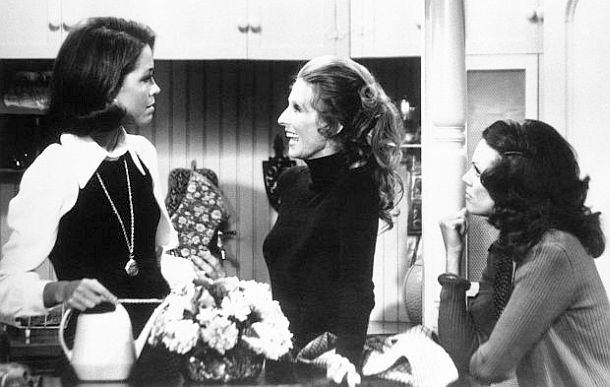
Mary Richards (Mary Tyler Moore), Phyllis Lindstrom (Cloris Leachman), and Rhoda Morgenstern (Valerie Harper), at Mary’s apartment in a scene from the 1970s TV sitcom, “The Mary Tyler Moore Show.”
But prior to the fall of 1970, there was no woman quite like Mary Richards on television — no single, 30-year old woman who had just broken off a live-in relationship with her boyfriend, then heading off on her own to a new town and new job. At the time, it was new territory, and at least half of the viewing audience was paying attention. Oprah Winfrey, for one, became a big fan, citing Moore’s portrayal of a woman in the workplace as inspirational. Winfrey, in fact, began her own on-air career at a local news station in Nashville during the initial run of The Mary Tyler Moore Show.
While Moore herself was not a feminist in the Gloria Steinem mold, she and the show did advance the cause of women’s rights, and other social issues. The show itself, as an employer, made inroads on the number of women in production. By 1973, 25 out of 75 writers on the show were women, which was revolutionary at the time.In the show’s storyline, meanwhile, when Mary discovers she was making less than the man who had the job before her, she argues for equal pay and eventually ends up with a raise, though the amount doesn’t totally make up the difference. And other issues also received an airing in the show’s comedic plots.
In the third season, pre-marital sex and homosexuality were among those included. In the fourth season, marital infidelity and divorce were explored. In the fifth season, Mary was jailed for contempt of court when she refused to reveal a news source. In the final seasons, other issues, including juvenile delinquency, intimate marital problems, infertility, and adoption were raised. Mary also becomes addicted to sleeping pills at one point, with her battle to break the addiction becoming part of the storyline.
During the heyday of The Mary Tyler Moore Show, Mary and others from the show frequently appeared on the covers of popular mainstream magazines, including Time, People, TV Guide, Ladies Home Journal, Family Circle, McCall’s, The Saturday Evening Post, and others. Time’s October 28th, 1974 edition featured Moore and Valerie Harper on the cover with the tagline, “TV’s Funny Girls,” offering a glowing review of both actors, and coming at a time when a separate Rhoda show had already spun off from The Mary Tyler Moore Show, with both shows then doing quite well, with nearly 30 million viewers between them.
 TV Guide, December 8-14, 1973. |
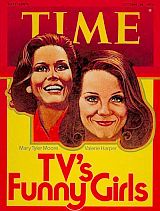 Time, October 28, 1974. |
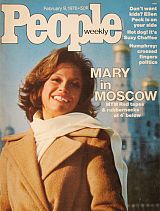 People, February 1976. |
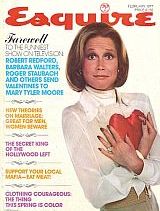 Esquire, February 1977. |
“One of these leading ladies is sweet, the other spicy,” offered Time in its October 1974 cover story describing Mary and Rhoda. “One is conservative, the other radlib. One is tranquil, the other seems to have been born with sand under her skin. Doublehanded, they are bringing a new sophistication back to television entertainment.” Such prominent magazine and print coverage helped keep The Mary Tyler Moore Show and its characters at the center of that day’s popular culture. And even as the show moved toward signing off in 1977, there was more good press. Esquire magazine gave Mary and the show a February 1977 feature story with Mary on the cover holding a Valentine heart with the tagline: “Farewell To the Funniest Show on Television: Robert Redford, Barbara Walters, Roger Staubach, And Other Send Valentines to Mary Tyler Moore.”
The Mary Tyler Moore Show also had an influence on television programming that followed, spinning off several new shows built around its characters – namely, Rhoda, as already mentioned, but also Phyllis and Lou Grant. It also influenced the content and structure of other TV programs. Tina Fey, creator and lead actress of the 2006 sitcom, 30 Rock, explained that Moore’s show helped inspire 30 Rock‘s emphasis on office relationships. “Our goal is to try to be like The Mary Tyler Moore Show, where it’s not about doing the news,” said Fey. Entertainment Weekly has also noted similarities between 30 Rock characters and those of The Mary Tyler Moore Show.
The show also collected numerous honors and kudos during its run and for years after. Even through the 1990s, the show continued to collect praiseworthy notice. In 1997, TV Guide selected a Mary Tyler Moore Show episode as the best TV episode ever, and in 1999, Entertainment Weekly picked Mary’s hat toss in the opening credits as television’s second greatest moment. More recently, in the 2002-2013 period, The Mary Tyler Moore Show has been rated variously as among the best TV shows ever by TV Guide, USA Today, Entertainment Weekly, Time magazine and the Writers Guild of America.
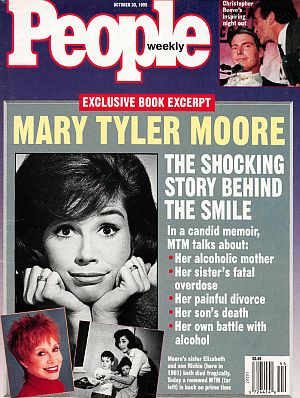
People magazine of October 30th 1995, touting exclusive excerpt from Mary Tyler Moore’s book, “After All.”
Her marriage to Grant Tinker, her second, had begun to go bad in the mid -1970s, this while she was still doing The Mary Tyler Moore Show. And her son from her first marriage, Richie, then still in high school, was having drug problems. By the mid-1970s as well, she was also drifting into alcoholism, a problem for which she would later seek treatment at the Betty Ford Center in 1984.
“I took to making margaritas in the blender,” she would write in her book. “My recipe was a quarter of a blender of bottled mix, one quarter of ice, one half of tequila and shake it up, baby! It had the consistency of a milk shake and the effect of morphine.” Of her new found single life upon separating from Grant Tinker, she would write: “I had never experienced any of the situations around which The Mary Tyler Moore Show had been based—an independent woman carving out a career, finding her way in a strange city, making new friends, doing exactly what I wanted – alone! So what if I was now 43 years old. I rented a house on East 64th Street, where I could experiment with my impression of that hard-to-beat gal Mary Richards.” But a crushing blow came in October 1980 with the death of her son, Richie, shot accidentally when a “hair trigger” shotgun he was holding went off.
Moore has been diabetic for some 30 years – first diagnosed during The Mary Tyler Moore Show – and she became chairwoman of the Juvenile Diabetes Foundation, devoting a share of her time to fund-raising and education. In 2005, in her capacity with the Juvenile Diabetes Foundation, she went to Capitol Hill to testify in support of expanding federal policy and increased funding for embryonic stem cell research.
Politics. Politically, during the 1960s and 1970s, Moore had been something of moderate liberal. In 1980, she endorsed President Jimmy Carter for re-election in a TV campaign ad (see video at left). And in 1988, she contributed more than $10,000 to Democratic candidates. By the 2000s, however, she had become more conservative. In a March 2009 Parade magazine article, Moore called herself a “libertarian centrist.” By then she was also lamenting the state of television, finding few shows of personal interest. “I do watch a lot of Fox News,” she told Parade. “I like Charles Krauthammer and Bill O’Reilly… If McCain [U.S. Senator John McCain, Republican Presidential candidate in 2008] had asked me to campaign for him, I would have.” On the 2013 PBS TV series, Pioneers of Television, Moore said that she was “recruited” to join the feminist movement of the 1970s by Gloria Steinem, but did not agree with all of Steinem’s views. Moore believed women have an important role in raising children and that she did not believe in Steinem’s view that “women owe it to themselves to have a career.”
Civil War. Moore has also been active in Civil War preservation, influenced by her father’s interest in Civil War history. In 1995, she donated funds to acquire an historic building in Shepherdstown, West Virginia, to be used as a center for Civil War studies at Shepherd University. The Conrad Shindler House, which is named in honor of her great-great-great-grandfather, who owned the structure in the 1800s, is now the George Tyler Moore Center for the Study of the Civil War in affiliation with Shepherd University. The house was used as a Confederate headquarters during 1861–62 by General “Stonewall Jackson. Moore’s great-grandfather, Lieutenant Colonel Lewis Tilghman Moore, was a commander in the Virginia infantry and offered Jackson the use of the home. Moore has also worked on behalf of animal rights issues, helping to raise awareness about the treatment of animals in agriculture and factory farms. She has also advocated the adoption of animals from shelters as opposed to killing them, and has worked with fellow actress Bernadette Peters to have New York City adopt a no-kill policy for its shelter animals.Book Tour. In 1996, when Moore was doing a book tour for the paperback version of After All, she made a stop in Minneapolis, where The Mary Tyler Moore Show had been set. At a book signing at the Mall of America, an adoring crowd of about 5,000 people came out to see her, with cheers and calls of “we love you Mary”. State Rep. Bill Luther came to the book-signing to read Gov. Arne Carlson’s proclamation that the appointed day that Saturday was to be “Mary Tyler Moore Day” because of the positive recognition Moore brought to the state. A letter from then First Lady, Hillary Clinton, was also read at the book signing, which stated in part that Mary was a “pioneer for women in television. Her role on The Mary Tyler Moore Show was one of the first in which we recognized the positive influence a woman can have on her profession.”
|
TV Land Statue 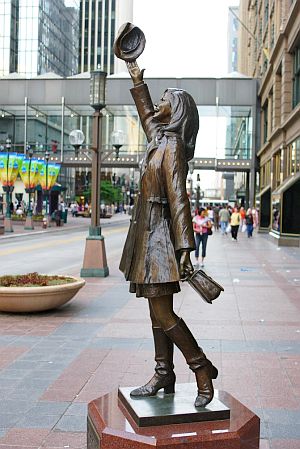 Mary Richards statue at the Nicollet Mall in Minneapolis, MN, early 2000s, commemorating The Mary Tyler Moore Show. The first TV Land statue honoring a fictional TV star was that for Jackie Gleason’s bus driver character, Ralph Kramden, of the popular 1950s’ Honeymooners TV show (which TV Land was then running in syndication). The Kramden statue was placed outside New York City’s Port Authority Bus Station in midtown Manhattan in August 2000. The second statue in the series was the Mary Richards character from The Mary Tyler Moore Show. The eight-foot Mary Richards statue was created by Milwaukee, Wisconsin sculptor Gwendolyn Gillen. Built and installed for a cost of $150,000. The statue was initially located in downtown Minneapolis in front of then Dayton’s department store (now Macy’s), near the corner of 7th Street and Nicollet Mall. It depicts the iconic moment in the show’s opening credits where Moore tosses her Tam o’ Shanter into the air. But in early 2001, as the proposal for the Richards statue was presented to the community, it met with some disapproval. In late March 2001, Marisa Helms of Minnesota Public Radio did a story on the forthcoming statue and she found that not everyone in Minneapolis was excited about having a bronzed Mary Richards installed in their fair city. “Why is TV Land putting up this statue?,” asked Tim Connolly of Minneapolis-Issues. 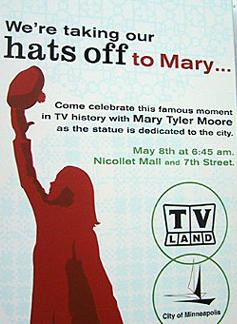 TV Land promotional advertising for the May 2002 unveiling of the Mary Richards statue. On a Wednesday morning of May 8th, 2002 at 7:00 a.m., the official installation of the Mary Richards statue took place. Some advanced advertising of the ceremony had occurred in the local media and from TV Land promotional material. A crowd of about 3,000 came out on a chilly, 43 degree morning. On hand for the ceremony were: Larry W. Jones, the General Manager of the TV Land cable channel; Minneapolis mayor, Raymond Thomas “R.T.” Rybak; Lisa Goodman, a member of the Minneapolis city council; and Mary Tyler Moore.  At the May 2002 unveiling in Minneapolis, Mary Tyler Moore tosses her tam near the statue featuring the famous TV show opening. (Pioneer Press /Joe Rossi) In 2015, the Richards sculpture was removed, along with other public art along the mall, during the street’s $50 million renovation project. Moore’s statue now stands at the city’s visitor center pending the completion of mall renovations. Steve Cramer, president of the Minneapolis Downtown Council, said residents notice and miss the statue when it’s not in its usual spot at the Nicollet Mall. “It’s not a unilateral decision that can be made here,” he said of re-installing the TV Land statue. “We love it, the city loves it. It’s a popular destination, so we want it back.” TV Land’s vice president of corporate communications, Jennifer Zaldivar-Clark, has stated that she expected the figure to be returned to its Nicollet Mall location once the project is completed in the summer of 2017. |
Later Career
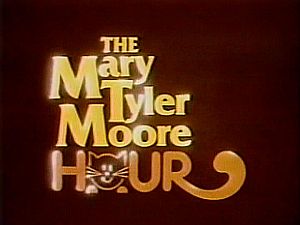
The Mary Tyler Moore Hour of 1979 featured Mary as a TV star putting on a variety show and ran briefly on CBS.
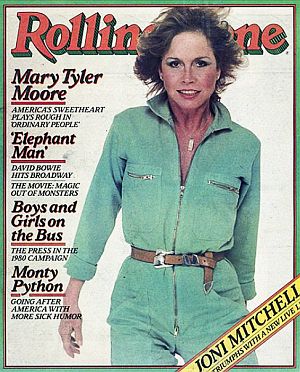
November 13th,1980: Rolling Stone cover with tagline: “America’s Sweetheart Plays Rough in Ordinary People.”
Back in the TV arena, in Finnegan Begin Again of 1985, she played a middle-aged widow who finds love. In the 1988 TV miniseries, Lincoln, she played Mary Todd Lincoln, the president’s troubled wife. In 1993 she won a Emmy for her role as best supporting actress in the TV film, Stolen Babies, a 1940s story about a Tennessee welfare worker played by Lea Thompson who learns that Moore’s character, Georgia Tann, a much respected head of a local adoption agency, is actually running a black-market baby ring.
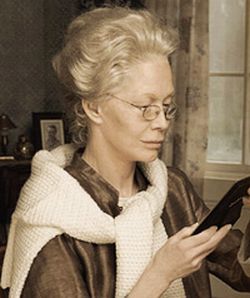
2003: Mary Tyler Moore in TV film as elderly recluse who helps raise an abandoned baby.
Mary Tyler Moore Show retrospectives and reunions also figured into Moore’s later TV career. In February 1991, CBS aired Mary Tyler Moore: The 20th Anniversary Show, which was a huge Nielsen ratings winner, receiving a 17.4 rating (16.2 million households). Another reunion show followed in 2002. Then in May 2008, the surviving cast members of The Mary Tyler Moore Show reunited on The Oprah Winfrey Show to reminisce about the series. Winfrey, a longtime admirer of Moore and the show, had her staff recreate the sets of the WJM-TV newsroom and Mary’s apartment for the reunion. In April 2009 Moore published her second memoir, Growing Up Again, which focused her living with type 1 diabetes. In May 2011, she underwent elective surgery to remove a benign brain tumor.
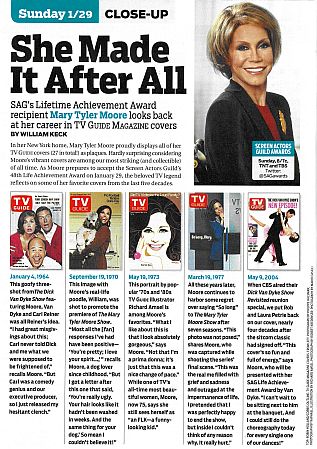
On the occasion of her 2012 SAG Lifetime Achievement Award, TV Guide took a look back at her career.
In September 2013, the women of The Mary Tyler Moore Show – Cloris Leachman, Valerie Harper, Mary Tyler Moore, Betty White, and Georgia Engel – were reunited on the TV Land sitcom, Hot In Cleveland. It was the first time in more than 30 years they had all been together. And in October 2015, PBS aired Mary Tyler Moore: A Celebration, featuring a retrospective of Moore’s career with laudatory comment throughout by a number of her former colleagues. Carl Reiner said she was “the Grace Kelly of comedians.” Others during the show described her as the “whole package” – the girl next store, a looker, a dancer, and a natural on stage. Dick Van Dyke noted she simply “got it” when it came to the providing the needed line or reaction in a comedic moment. And legend Lucille Ball, who once quietly watched Moore perform from a nearby soundstage, later told her, “you know, you’re really very good.” Still, some reviewers of the Moore PBS special found it a bit too hagiographic, looking for a fuller treatment of her life and career. No doubt, such works will come. Yet without question, Mary Tyler Moore helped change the direction of American television for the better, leaving a lasting impression on millions of television viewers.
See also at this website, “Noteworthy Ladies,” a topics page that includes links to 40 stories on other famous and notable women, including others who have worked in television such as, Lucille Ball, Dinah Shore, and Barbra Streisand. See also the “TV & Culture” page for additional stories in that category. Thanks for visiting – and if you like what you find here, please make a donation to help support the research and writing at this website. Thank you. – Jack Doyle
|
Please Support Thank You |
____________________________________
Date Posted: 30 January 2016
Last Update: 19 March 2023
Comments to: jdoyle@pophistorydig.com
Article Citation:
Jack Doyle, “Mary Tyler Moore: 1950s-2010s,”
PopHistoryDig.com, January 30, 2016.
____________________________________
Sources, Links & Additional Information
 Dec 1961: Mary Tyler Moore & Dick Van Dyke on TV Guide cover for “The Dick Van Dyke Show.” |
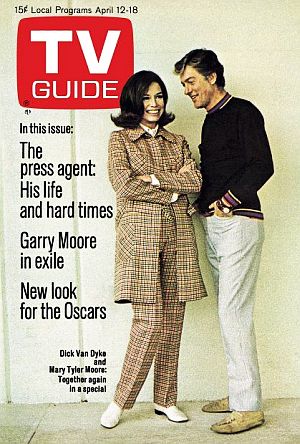 April 1969: TV Guide features Dick Van Dyke & Mary Tyler Moore for a TV special that helped Mary win her CBS contract that led to “The Mary Tyler Moore Show.” |
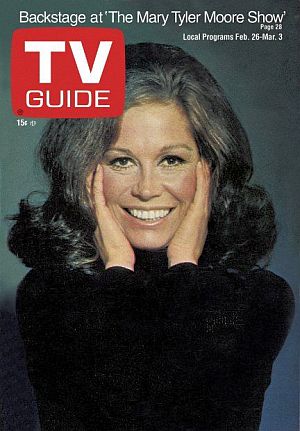 Feb 1972: TV Guide cover story: “Backstage at The Mary Tyler Moore Show.” |
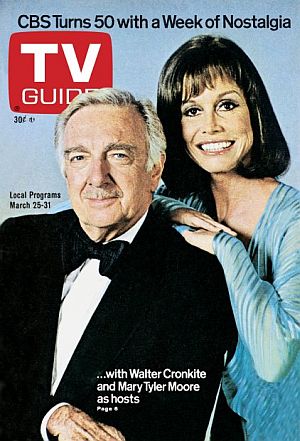 March 1978: Mary Tyler Moore with CBS newsman, Walter Cronkite, hosts of “CBS Turns 50" anniversary special. |
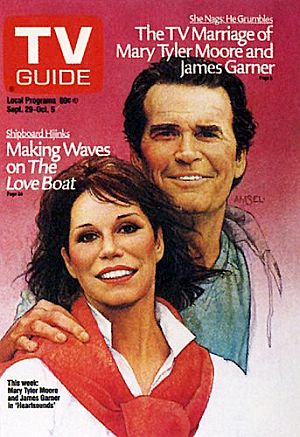 Sept 1984: TV Guide cover with Mary Tyler Moore & James Garner, featuring TV film “Heartsounds,” for which both were Emmy-nominated. |
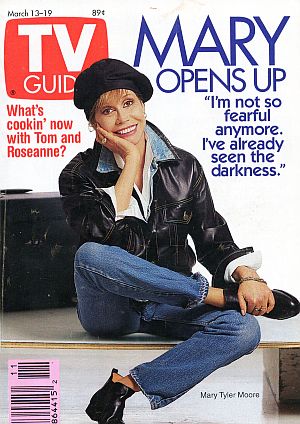 March 1993: TV Guide cover story, Mary Tyler Moore “opens up.” |
Tim Brooks and Earle March, “The Mary Tyler Moore Show,” The Complete Directory to Prime Time Network and Cable TV Shows, 1946-Present, New York: Random House / Ballantine Books, Eighth Edition, 2003, pp. 748-749.
Geoff Hammill, “The Mary Tyler Moore Show; U.S. Situation Comedy,” Museum.TV.
“The Mary Tyler Moore Show,” Wikipedia .org.
Hedda Hopper, “Mary Tyler Moore Has Many Talents,” Los Angeles Times, April 21, 1964, p. C-8.
Joanne Stang, “Housewife Without Traumas,” New York Times, May 9, 1965.
“Mary Tyler Moore Signs CBS Pact,” Los Angeles Times, September 18, 1969, p. D-16.
“Mary Tyler Moore Researches a Role,” Washington Post, Times Herald, August 16, 1970, pp. 30-31.
George Gent, “TV Will Drip Social Significance; New Season’s Shows to Be Relevant and Youthful,” New York Times, September 7, 1970.
John Leonard, “The Subversive Mary Tyler Moore; Woman’s Role on TV,” Life, December 1970, p. 8.
Cecil Smith, “Mary Tyler Moore: Her Charisma Makes the Comedy Show go,” Los Angeles Times, December 13, 1970, p. V-2.
“Mary Tyler Moore: Reason to Smile,” Washington Post, Times Herald, February 21, 1971, p. 33.
Dan Menaker, “Don’t Look Now, But TV Is Growing Up,” New York Times, May 20, 1973.
Cecil Smith, “Mary Tyler Moore Show and The Waltons Win Key Emmys,” Los Angeles Times, May 21, 1973, p. A-1-A-2.
Gloria Banta, “Is Television a Man’s World? Yes, Ma ‘am,” New York Times, September 30, 1973.
Joyce Maynard, “Is Mary Tyler Moore Too Good to Be True?,” McCall’s, March 1974.
Tracy Johnston, “Why 30 Million Are Mad about Mary; What’s a Tv Star? Someone Who Is Beautiful and Sexy, but Not Threatening,” New York Times, April 7, 1974.
Cecil Smith, “Mary Tyler Moore to Be Host-Narrator of ‘We the Women’ Special,” Los Angeles Times, March 17, 1974, pp. M-1-M-2.
“TV’s Reigning Queen: With The Success of MTM and MTM Enterprises, Mary Tyler Moore Is This Year’s Queen of the Living Room Screen,” People, September 30, 1974.
“The Mary Tyler Moore Show,” Wikipedia .org.
Lawrence Laurent, “Mary Tyler Moore-the Dancer Who Became a Big Corporation,” Washington Post, August 3, 1975, pp. 165-166.
Les Brown, “TV Notes: Hard Luck, Sexism and Maybe a Surprise Hit,” New York Times, September 14, 1975.
William E. Farrell, “Minneapolis Enjoying Heyday as an Upbeat Metropolis,” New York Times, September 16, 1975.
Judith Martin, “Mary Tyler Moore: On The Hill…,” Washington Post, November 18, 1975, p. B-7.
John J. O’ Connor, “TV: The Kind of Show a Star Should Never Do; Miss Moore’s Special Trite and Pretentious ‘Incredible Dream’ on CBS Tonight at 10,” New York Times, January 22, 1976.
“Asner, Walker Win Emmy Prizes; ‘Rich Man’ Father, Abigail Adams Roles Cited,” New York Times, May 18, 1976.
“Mary Tyler Moore’s Mission to Moscow,” TV Guide, June 26, 1976.
AP, “Mary Tyler Moore, at Series’ End, Can Now Savor Its Innovations,” New York Times, February 3, 1977.
C. Gerald Fraser, “Humanitas Prizes Go to 4 TV Writers; ‘Green Eyes’, Episodes of ‘Roots’ and ‘Mary Tyler Moore Show’ Earn Authors Awards,” New York Times, July 9, 1977.
John J. O’ Connor, “TV: CBS Presents ‘Lou Grant’; ‘Comedic’ Spin-Off Moves Asner From Electronic Newsman to City Editor of Major Paper,” New York Times, September 20, 1977.
John J. O’ Connor, “TV: Mary Tyler Moore Does a Musical,” New York Times, February 22, 1978.
“CBS Cancels ‘Mary,’ But Not Mary Tyler Moore,” Los Angeles Times, October 14, 1978, p. B-4.
Lawrence Laurent, “’First You Cry’ Stars Mary Tyler Moore,” Washington Post, November 5, 1978, p. TV-5.
Tom Shales, “Mary Tyler Moore, Out on a Limb,” Washington Post, March 3, 1979, pp. B-1-B-2.
“Mary Tyler Moore, Husband Separate,” Los Angeles Times, December 29, 1979, p. A-21.
“Actress’ Son Dies; Mary Tyler Moore’s Only Child, 24, Shoots Self,” Washington Post, October 16, 1980, pp. F-1-F-2.
“America’s Sweetheart Plays Rough in ‘Ordinary People’” (cover story), Rolling Stone, November 13, 1980.
Judy Klemesrud, “Sunshine Girl Becomes Girl You’ll Love to Hate,” New York Times, September 24, 1980.
“Mary Tyler Moore Leaves Alcohol Treatment Clinic,” Los Angeles Times, October 6, 1984, p. 24.
Sally Bedell Smith, “TV Notes; ‘Mary Tyler Moore’ May Play Another Encore,” New York Times, January 19, 1985.
Jane Feuer, Paul Kerr & Tise Vahimagi (eds.), MTM ‘Quality Television’, British Film Institute, June 1985, 308pp.
“MTM Enterprises,” Wikipedia.org.
“Mary Tyler Moore’s New TV Series,” Washington Post, June 22, 1985, p. C-8.
Morgan Gendel, “Mary’s Back in Character,” Los Angeles Times, October 30, 1985, p. E-1.
Paul Weingarten, “The Kitten That Roared: At MTM They Really Believe That Quality, Too, Can Win An Audience,” Chicago Tribune, December 1, 1985
Michael E. Hill, “Mary Tyler Moore,” Washington Post, December 8, 1985, p. 13.
Vincent Canby, “Mary Tyler Moore: a Sitcom Prisoner,” New York Times, March 30, 1986.
Stephen Farber, “Mary Tyler Moore to Get Another Chance on CBS,” New York Times, May 27, 1986.
Mel Gussow, “The Theater: ‘Sweet Sue,’ with Moore and Redgrave,” New York Times, January 9, 1987.
William K. Knoedelseder Jr., “ MTM Reported Sold to British Television Firm: Financial Times of London Says Price Is $325 Million,” Los Angeles Times, July 2, 1988.
Andrea Adelson, “Television South Purchases MTM,” New York Times, July 7, 1988.
“Mary Tyler Moore: Adorable, Funny, Hugely Talented—With the Force of a Magnet She Attracted Millions of Viewers to a New Kind of TV Woman,” People, May 4, 1989.
John J. O’ Connor, “Review/Television; An Updated Mary Richards in ‘Murphy Brown’,” New York Times, November 27, 1989.
Robert S. Alley and Irby B. Brown, Love Is All Around: The Making of the Mary Tyler Moore Show, New York: Delta, With Foreword by Grant A. Tinker, 1989.
Joyce Purnick, “Editorial Notebook; The Legacy of Mary Richards,” New York Times, February 20, 1991.
Rick Du Brow, “Mary Tyler Moore Show [in reruns] a Marathon of Change,” Los Angeles Times, September 19, 1992, p. F-3.
John J. O’connor, “Review/Television; Mary Tyler Moore’s Smile Turns Evil”[re: Stolen Babies], New York Times, March 25, 1993.
Shelley Levitt, “Success Becomes Her,” People, August 30, 1993 Vol. 40 No. 9
Mike Cidoni, “`Mary Tyler Moore Show’ Makes It – Again,” Chicago Sun-Times, September 1, 1993.
Susan King, “Licensed to Steal: Adoption Scandal Is Subject of Lifetime’s ‘Stolen Babies,’ with Mary Tyler Moore as Georgia Tann,” Los Angeles Times, March 21, 1993.
“Behind Her Smile; TV Legend, Mary Tyler Moore, In An Exclusive Excerpt, Looks Back at a Marriage That Failed and a Son Who Died Too Soon,” People, October 30, 1995 Vol. 44 No. 18
“Mary Tyler Moore,” Wikipedia.org.
Steve Johnson, Tribune Television Critic, “The Mary Tyler Moore Show: When in Doubt on the TV Beat….” Chicago Tribune, November 1, 1995.
Diane Rafferty “Mary, Queen of Sitcoms”[Review of After All, by Mary Tyler Moore], New York Times, December 3, 1995.
Martie Zad, “Mary Tyler Moore in Moving Role” [TV Review, “Stolen Memories: Secrets From the Rose Garden,” Family Channel], Washington Post, January 7, 1996, p. Y-4.
Molly Guthrey, “From the Archives: Mary Tyler Moore Tours Her Minneapolis ‘Home’,” (1996 story reposted), TwinCities.com, December 9, 2015.
“Mary, Mary, Quite Contrary,” New York Times Magazine, December 17, 1995.
Robert J. Thompson, Television’s Second Golden Age, Syracuse University Press, 1997, 220 pp.
Peter Marks, “Like ‘Mary Tyler Moore,’ With Attitude and Accent,” New York Times, March 30, 1997.
Frank Decaro, “Toss Your Hat: Mary and Rhoda Return,” New York Times, December 7, 1997.
David Rakoff, “The Way We Live Now: 1-30-00: Questions for Mary Tyler Moore; Mary Richards,” New York Times Magazine, January 30, 2000.
Marisa Helms, “Mary Tyler Moore Statue Stirs Debate,” Minnesota Public Radio, March 30, 2001.
Ellen Crean, “Time To Toss Your Tam– Mary Tyler Moore’s Minneapolis Statue,” The Early Show, CBS News.com, May 8, 2002.
Neal Justin, “Turning the Mall On With Her Smile; The Loving Crowd at the Dedication of the Mary Tyler Moore Statue Proved that Mary Richards’ Experience Still Resonates,” Minneapolis Star-Tribune (Minneapolis, MN), May 9, 2002.
“Mary Richards Statue,” TVAcres.com, May 2002.
David Kirby, Television/Radio, “Need a New Show? Just Dip Into Television’s Past,” New York Times, August 18, 2002.
Michael Kuchwara, “Mary Tyler Moore Exits Neil Simon Play; Collaboration ‘Did Not Work Out,’ Manhattan Theatre Club Says,” Los Angeles Times, December 6, 2003, p. E-22.
Chris Kaltenbach, “The Legend of Ted Baxter; Will Ferrell’s ‘Anchorman’ Owes a Spiritual Debt to the Blowhard Newsman of Television’s ‘The Mary Tyler Moore Show’,” Los Angeles Times, July 16, 2004, p. E-31.
James Poniewozik, “17 Shows That Changed TV,” Time, Thursday, September 6, 2007.
Mark Harris, “Wanted: Mary Richards, All of Her,” New York Times, August 29, 2008.
Molly Driscoll, “Mary and Lou and Rhoda and Ted: 8 Stories From the Making of ‘The Mary Tyler Moore Show’,” Christian Science Monitor, 2013.
Kevin Sessums,. “Mary Tyler Moore’s Lifetime of Challenges,” Parade, March 22, 2009.
Mary Mcnamara, “Independent-Minded, as Always; Mary Tyler Moore Doesn’t Watch the Modern Single-Gal Sitcoms. It’s Been Done, She Says,” Los Angeles Times, January 29, 2012, p. D-1.
Jennifer Keishin Armstrong, Mary and Lou and Rhoda and Ted: And All the Brilliant Minds Who Made The Mary Tyler Moore Show a Classic, New York: Simon & Schuster, 2013, 324 pp.
Hope Reese, “The Real Feminist Impact of The Mary Tyler Moore Show Was Behind the Scenes,”
TheAtlantic.com, May 16, 2013.
Barbara Kay, “Mary Tyler Moore: Last of the TV ladies,” National Post(Canada), June 12, 2013.
“Book Review: ‘Mary and Lou and Rhoda and Ted’ by Jennifer Keishin Armstrong,” Washington Post, July 27, 2013.
Jennifer Keishin Armstrong, “The 12 Best Episodes of The Mary Tyler Moore Show Not Involving Chuckles,” Vulture.com, September 4, 2013.
Soraya Nadia McDonald, “Mary Tyler Moore’s Friends Say Diabetes Has Rendered Her Nearly Blind,” Washington Post, May 22, 2014.
Liz Sawyer and Paul Walsh, “Mary Tyler Moore Statue Taking a Station Break from Nicollet Mall in Minneapolis,” Star Tribune, October 4, 2015.
Josef Adalian, “John Amos on Mary Tyler Moore, Racism on Set, and Playing the First Black Family Man,” Vulture.com, October 13, 2015.
Susan McLeland, “Grant Tinker, U.S. Producer/Media Executive,” Museum.TV.
_________________________________
